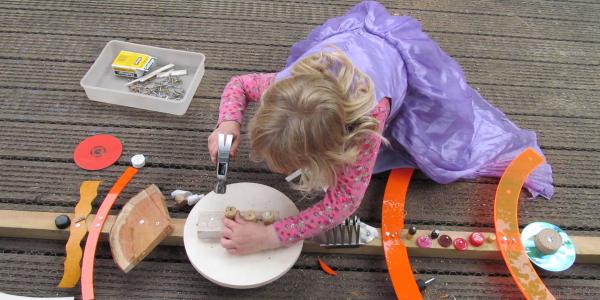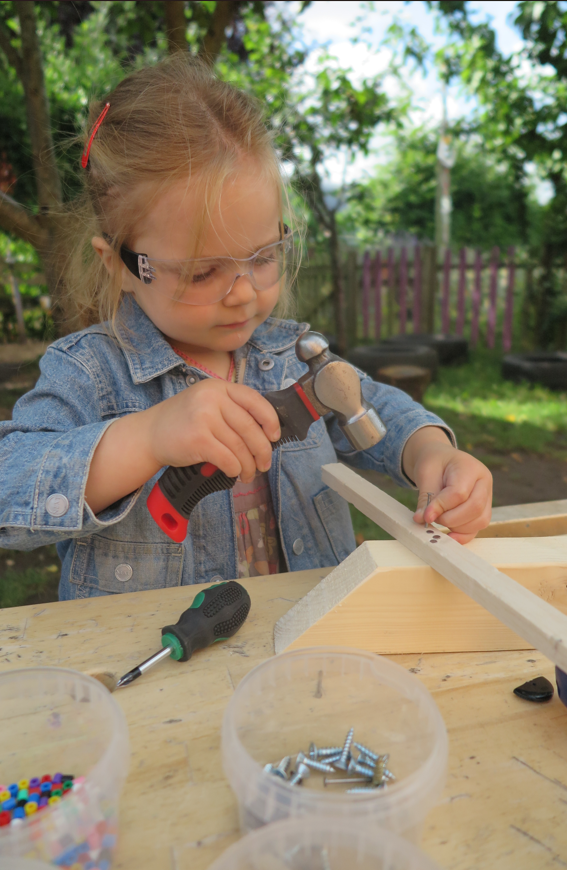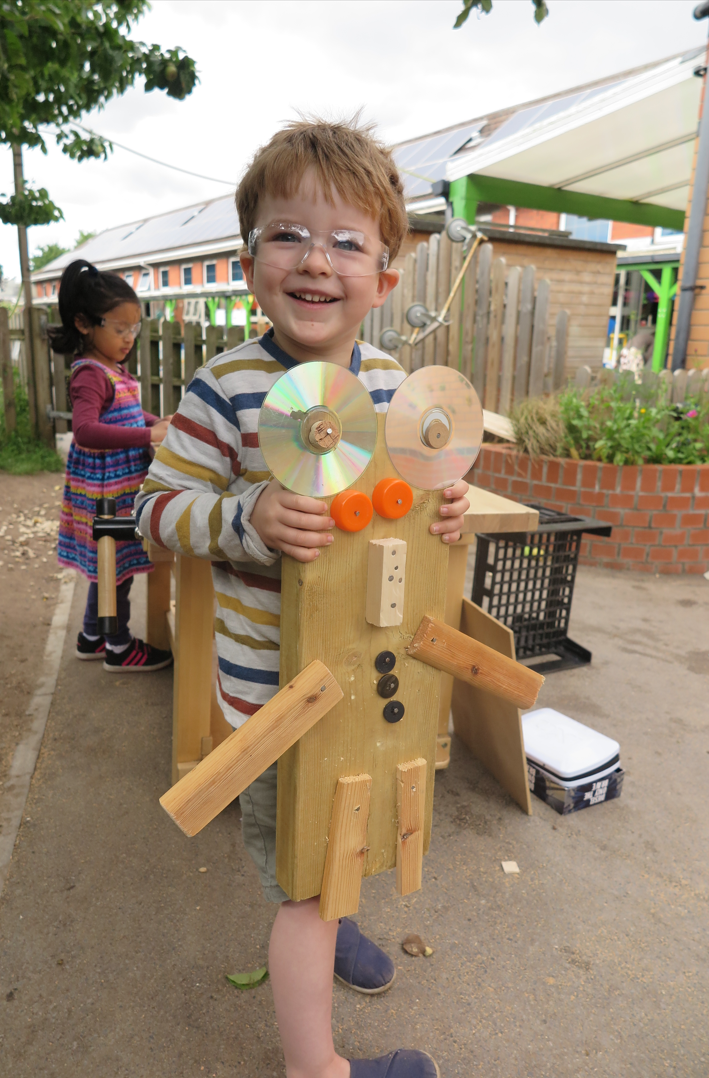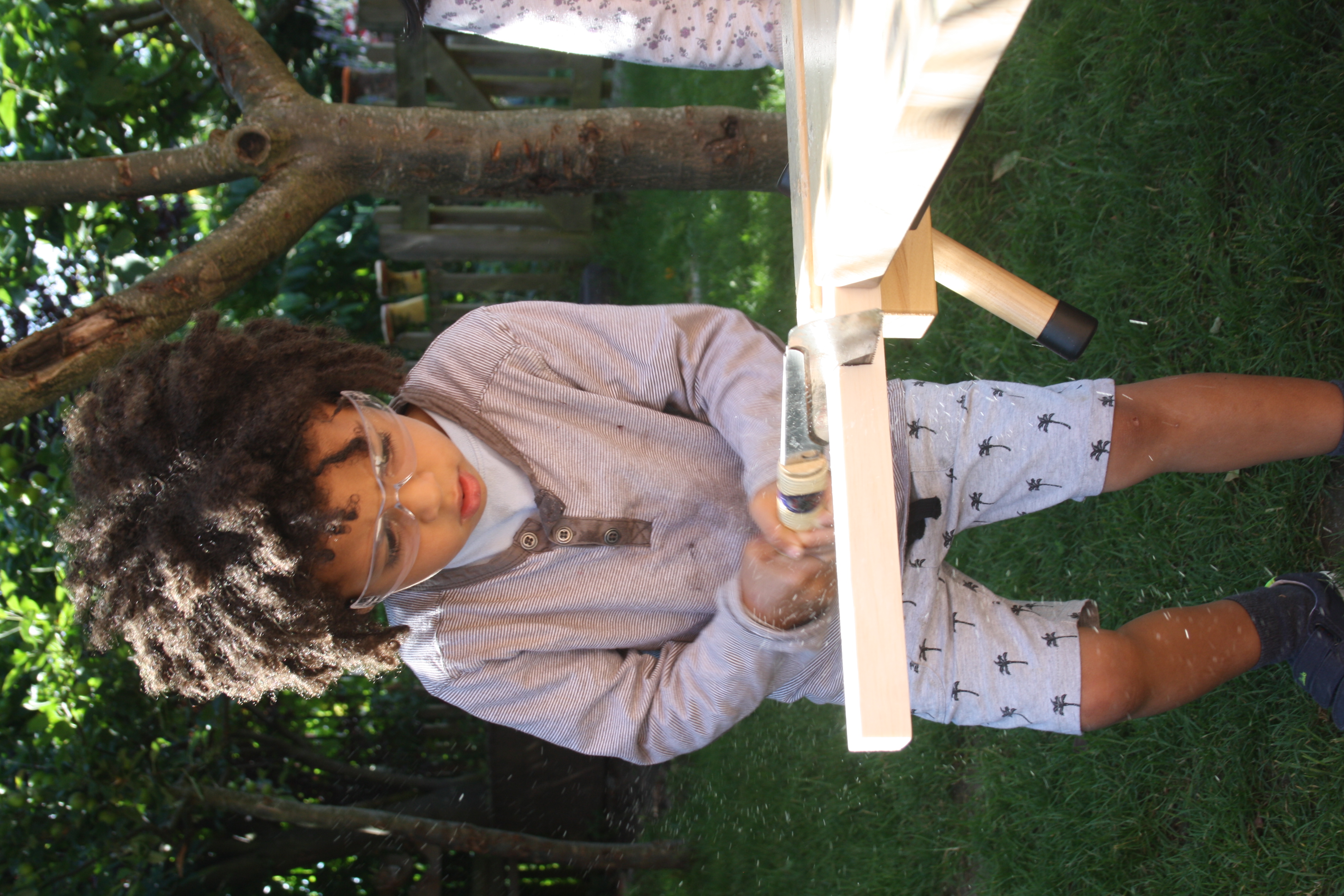The Wonder of Woodwork in Early Childhood: Exercising Imagination, Creativity, and Problem Solving

You are here
Millie, age 4, uses a hammer, hand drill, screwdriver, and a small pull saw. She’s designing a bed for one of her dolls. Under the supervision of Pete, the woodworking educator, she saws pieces of wood with focus. Using the hammer, she carefully nails the four legs to the bed. She stands the bed up. She’s disappointed to discover that it’s wobbling. She examines it and realizes that one leg is too long. She assesses how to tackle the problem, then gets an idea for what to do next—she removes the leg that’s too long and begins working on its length.
In the opening vignette, Millie was deeply engaged and focused on her creation, which was part of a continuous project in her early learning setting. Woodworking certainly presents a lot of problems for young children to navigate and resolve. Through her efforts, Millie turned wood into a functional and aesthetically pleasing bed, but she was the one experiencing the real transformation—putting her ideas into action, gaining mastery with tools, exercising her sense of agency, and feeling her confidence grow. Woodworking allows children to use their hands and minds to express their imaginations and solve problems in the process of making. It’s a sensory activity that captivates young children’s interests: They can smell and feel the different pieces of wood and listen to the sounds of hammering and sawing as they work.
Woodworking benches were common in early learning settings from the early 1900s until the 1990s. (See “The History of Woodworking in Early Childhood Education” below.) Teachers who have continued the practice of woodworking with young children regularly observe their sustained focus and engagement and their perseverance with challenging tasks. Woodworking draws children in and allows them to learn at their own pace as they explore possibilities and find solutions to complex problems. Once they master basic woodworking skills, they can begin tinkering, making, and engineering—key elements of science, technology, math, and engineering (STEM) learning—as they draw on their emerging knowledge of tools to create new forms.
I have worked in schools and early learning settings for over 25 years as a creative consultant and an artist-educator. In this article, I share experiences from my work with two 4-year-olds, Millie and Sam. I discuss the history and benefits of integrating woodworking into early childhood education settings and provide guidance about how to safely embed woodworking within practice. By supporting children’s woodworking experiences, I have been able to focus on and nurture their creativity. Through supporting, planning, and implementing safety measures, I have found that woodworking can be a developmentally appropriate experience to introduce to children as young as 3.
The History of Woodworking in Early Childhood Education
In recent years, there’s been renewed interest in woodworking in the United States, coinciding with the emergence of makerspaces and upcycling. Within early childhood education, there is a resurgence of forest school programs and nature-based approaches in a variety of other early learning settings. A focus on woodworking for young children has a rich history, beginning with Friedrich Froebel, a German-born educator who pioneered the first kindergarten in the mid-1800s. His views, such as those that emphasized the importance of children’s play, imaginations, and creativity, were revolutionary at the time. He identified woodworking as an occupation, one of several hands-on activities that encouraged children to transform materials into other objects.
In the US, there were many early adopters who integrated woodworking into curriculum for young children. In the 1880s, the Eliot School in Boston offered teachers training on designing woodworking learning experiences. The City and Country School in New York City—established in 1914 by Caroline Pratt, a keen woodworker herself—continues to offer woodworking for children as young as 4. The School in Rose Valley, established in 1929 in Media, Pennsylvania, has had a long tradition of offering woodworking for children as young as 3. Its first classroom was a wood shop—a place that continues to be the heart of the campus. It was created to promote the knowledge and skills that support problem solving and to provide opportunities for young learners to gain confidence by meeting the goals they’ve created.
Ensuring Safety When Woodworking
In more recent decades, woodworking fell out of favor in many early learning programs over concerns about potential accidents and legal issues. It’s natural for educators who don’t have experience with woodworking to feel apprehensive. For some, the activity may conjure images of children wielding saws and causing serious mishaps. However, educators can introduce woodworking with intention and with safety measures in place. This approach maintains healthy and safe environments, ensures it is low risk, and allows children to understand and manage risk. Children are also provided with opportunities to practice self-control and agency and to build knowledge and skills that can help them remain safe in other situations too.
 To ensure that children understand why health and safety measures are in place, educators should spend time explaining the reasons for these measures. They can draw their attention to possible hazards and instruct and model the correct use of tools. Educators should also consider where and when woodworking materials are available. Once children have gained experience in how to carefully and appropriately use tools, they can begin working more independently. When teaching children about the purpose and proper use of tools, educators can intentionally arrange them into groups by considering what works best for the children in their specific settings. Based on my experiences, the following groupings generally work well: 3- to 4-year-olds, groups of three or less; 4- to 5-year-olds, groups of four or less; and 6- to 8-year-olds, groups of eight or less. However, when using a saw, children should always continue to be monitored one-on-one.
To ensure that children understand why health and safety measures are in place, educators should spend time explaining the reasons for these measures. They can draw their attention to possible hazards and instruct and model the correct use of tools. Educators should also consider where and when woodworking materials are available. Once children have gained experience in how to carefully and appropriately use tools, they can begin working more independently. When teaching children about the purpose and proper use of tools, educators can intentionally arrange them into groups by considering what works best for the children in their specific settings. Based on my experiences, the following groupings generally work well: 3- to 4-year-olds, groups of three or less; 4- to 5-year-olds, groups of four or less; and 6- to 8-year-olds, groups of eight or less. However, when using a saw, children should always continue to be monitored one-on-one.
The following provides additional details about safety precautions with woodworking materials.
- Provide safety glasses: To eliminate risk of eye injury, children should wear properly fitting safety glasses. Safety glasses are often more comfortable for children than goggles and can allow for greater visibility.
- Monitor sawing: When a child is using a saw, they should be the only one sawing (one child at a time). There should be at least two adults in the woodworking area. Each child using a saw should be monitored by an adult, and an additional adult should stand in the area to ensure that other children are watching or working safely when nearby.
- Use safe sawing procedures: Pull saws can be held with both hands. They are much easier and safer for young children to use. When using the saw, an adult should ensure that the wood is securely clamped in a vise. After use, an adult should place the saw out of children’s reach.
- Teach safe hammering: Children should first learn about how to hammer safely by holding the nail in place and gently tapping it until it stands up on its own. Before hammering the nail with more force, children should learn to hold the wood in a way that prevents them from accidentally striking their fingers or hands.
- Work to avoid splinters: To limit children’s exposure to splinters, teachers should carefully choose smooth, pre-sanded wood. If sourcing cut or found wood, teachers should check that edges and any rough areas have been thoroughly sanded.
Introducing Woodworking to Children
Four-year-old Sam draws a plan for building a train. Then he gathers wood and other supplies. When it’s time to attach the wheels, Pete watches as he hammers them on. Sam eagerly places the train on the floor to test it. The wheels don’t touch the ground. Pete can see that Sam is disappointed, but Sam decides to try again and goes back to the workbench. After turning the train over, Sam realizes the problem—the wheels need to hang over the body of the train. He takes them off, moves them down, and tests the wheels again. This time, he’s delighted to see that his fix worked, but a new problem emerges: The wheels won’t rotate.
“I wonder if there’s anything we could do to help the wheels turn?” Pete asks.
Sam finds some toy cars and examines them. Seeing the ease with which their wheels turn, he realizes that his are too firmly attached. He takes the train back to the workbench and uses the claw opposite the head of the hammer to ease the nails out a little more. When he tests his creation a third time, he’s satisfied to see his train move.
Sam exhibited a strong motivation to engage in important STEM skills, including inquiry, analysis, and reflection. While watching him, I was able to support his process of problem solving. He possessed the confidence and competence to keep trying. Woodworking can promote an exploratory and problem-solving mindset: At the workbench, children become tinkerers, designers, makers, and engineers. With educator planning and support, woodworking provides incremental progression and complexity and can be responsive to individual learners’ interests, strengths, and areas for development.
Following are suggestions for supporting children to begin woodworking:
- When planning group sizes for woodworking experiences, consider factors such as children’s ages, experience levels, the number of adults available to provide supervision, and which tools and materials will be used.
- Support children’s beginning positive experiences with woodworking by providing manageable materials. For example, balsa wood is soft and easier to saw and hammer than the harder woods that children will eventually work with. Small wooden hammers can be used to hammer golf tees into materials such as cardboard boxes, clay, or pumpkins.
- Scaffold children’s progression of woodworking skills by beginning with easier tasks, such as inviting children to hammer thin wood together using small nails, before slowly introducing a wider selection of wood and nail sizes.
As children gain skills, knowledge, and confidence, educators can integrate woodworking as a continuous activity embedded within a learning setting’s schedule that taps into and promotes children’s interests, strengths, and agency.
Promoting the Strengths of All Learners Through Woodworking
Millie’s and Sam’s experiences show how woodworking can be a highly motivating activity. What’s more, woodworking can be effective in engaging a wide range of learners. For example, it has been shown to produce positive outcomes for children living in economically disadvantaged communities by drawing upon their curiosity, creativity, and ability to focus on a task that engrosses them. Woodworking can help address gender stereotypes that erroneously communicate the idea that girls can’t or don’t do woodwork. In my experience, there is no gender difference in woodworking once it has been introduced with intention. Teachers can support equitable access to and participation in woodworking by sharing books and other materials that feature people of various genders, ethnicities, and races as they tinker and make with wood. Teachers should also make sure that all children have the same opportunities to learn about and use tools. In that way, children can make an informed decision about whether and how they want to take part in woodworking.
Implementing Woodworking in an Early Learning Setting
Educators who are interested in providing woodworking experiences in their own settings may wonder where to begin. In this section, I discuss the beginning steps to consider and share guidance drawn from my correspondence with two educators who integrate woodworking into their curricula.
Research Regulations
Educators in the US will need to research possible state regulations, which may be attached to licensing. These regulations might specify rules for equipment and materials and involve a licensing representative who ensures compliance. Licensing representatives who visit programs may check on the condition of materials and equipment, make sure there are enough materials based on the number of children, and verify that woodworking experiences are used for instructional purposes.
Acquire Materials
While some educators may only need to dust down a workbench and dig out tools, integrating woodworking will mean starting from scratch for others. Educators at every level of experience will find that there are accessible and cost-effective ways to include woodworking materials and spaces in their settings. When creating a woodworking area, educators will need to collect tools and supplies like wood, corks, nails, screws, sandpaper, and safety glasses. A sturdy workbench and vise are essential for clamping wood tightly for children to saw safely.
However, it’s not necessary to make new purchases: Family, community members, and local businesses may be able to donate items. Educators can also visit community resale stores that stock building materials as well as estate and garage sales. In addition to finding items at a lower cost, sourcing properly functioning materials secondhand prevents them from going into landfills.
In terms of sustainability, woodworking helps counteract the culture of consumption and disposal by introducing children to the value of making and repairing. Children discover how they can repurpose materials by making models from a selection of recycled wood and other materials. In addition, when children understand where wood comes from, they can see its beauty and develop respect for nature, which can inspire a sense of responsibility for our shared environment.

Communicate with Families
I have very few concerns about risk because I took the time to get the professional development I needed. We have a 4:1 ratio in place for safety, strategies for introducing tools in a safe and timely way, and organization that will mitigate risk. I did send an informational letter home to parents sharing the benefits of woodworking.
—Stephanie Greer, educator and lab coordinator
Stephanie Greer is the design, robotics engineering, arts, and math lab coordinator at The Baldwin School, an all-girls private school in Bryn Mawr, Pennsylvania. She works with students from pre-K through the fifth grade. She encourages other educators to discuss the benefits, risks, and safeguards involved in woodworking with families. When planning to implement woodworking with young children, educators can inform family members through open houses, conferences, letters, newsletters, email messages, and so on. They can share about the history of woodworking within early childhood education and describe the rich learning and development children can experience. Communicating with families ahead of time will allow them to ask questions and discuss any concerns. In addition, educators can emphasize that the children’s safety is their most important priority, and they can detail their approach to health and safety during woodworking.
Prospective parents ask about the workbench during their school tour. As a parent of a child in our cooperative school, they see how the workbench is used and how the teacher facilitates woodworking to ensure the tools and materials are used safely. Each child receives guidance on wearing protective equipment and on how to safely use the tools, and we provide safety glasses and goggles as well as ear protection.
—Jill Rye, an early childhood educator
Jilly Rye is a preschool educator who teaches at Hobson School, a play- and nature-based school in Naperville, Illinois, where they’ve offered woodworking for over 40 years. Her statement highlights the importance of showing families the woodworking space, explaining what tools and materials are used, and communicating how safety is prioritized.
It's beneficial to offer opportunities for families to see a setting’s woodworking space and to watch their children woodworking. Prior to inviting families in, educators can discuss approaches that can support their children as they work on projects, including the importance of following the child’s lead. When family members see their child woodworking firsthand, they can gain greater insight into how to encourage their child’s creative development. The experience may even inspire them to try woodworking at home as a family.
Conclusion
Woodworking is a symbolic language of shape, form, and space. It encompasses a way of working that develops over time as children express their ideas with increasing fluency and complexity. As children tinker then construct and create, these experiences can combine to build a rich foundation for their emotional, physical, and STEM development.
Additional Resources
To learn more about the history of woodworking in early childhood education, its connections to early learning content, and how to plan woodworking activities, visit the “Resources” section on the Irresistible Learning website.
Photographs: courtesy of the author
Copyright © 2025 by the National Association for the Education of Young Children. See permissions and reprints online at NAEYC.org/resources/permissions.
 This article supports the following NAEYC Early Learning Programs standards and topics
This article supports the following NAEYC Early Learning Programs standards and topics
Standard 2: Curriculum
2G: Science
Standard 3: Teaching
3G: Using Instruction to Deepen Children’s Understanding and Build Their Skills and Knowledge
Pete Moorhouse is an early childhood creative consultant, international trainer, speaker, author, and researcher based in the United Kingdom. Visit Irresistible Learning for free resources and to learn more about the online and in-person trainings Pete delivers worldwide. [email protected]
